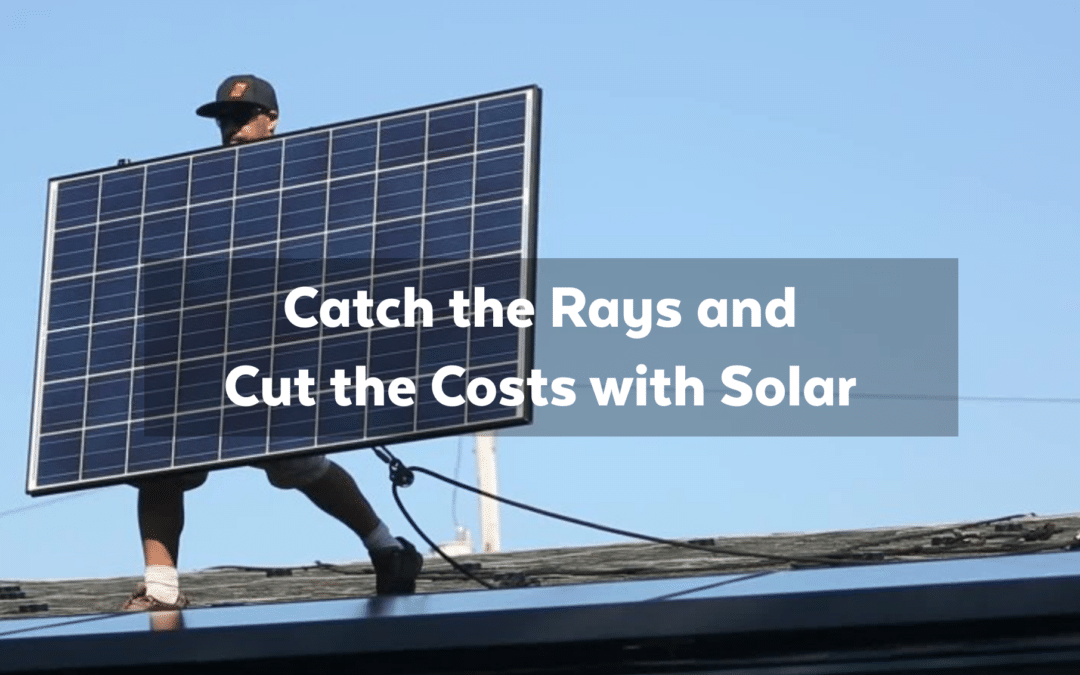
by Chris Hargreaves | Dec 13, 2025 | Case Studies, News, Solar Power
Solar Smarts: How Kiwi Businesses Are Winning with Sunshine
Overview
Total Utilities’ Solar Feasibility Review and Supplier Engagement initiative is designed to help businesses evaluate the technical, financial, and environmental benefits of solar energy. By leveraging proposals from trusted SEANZ-approved providers, we deliver clear, data-driven insights and supplier options tailored to your energy usage profile and sustainability goals.
Our Process
- Comprehensive Feasibility Review
- Technical Assessment: Analyse your site’s solar potential, roof structure, and energy consumption patterns.
- Financial Modelling: Calculate projected savings, ROI, and payback periods.
- Environmental Impact: Estimate carbon emission reductions and ESG alignment.
- Supplier Engagement
- Source competitive proposals from SEANZ-approved providers.
- Ensure quality, compliance, and performance guarantees.
- Provide financing options, including cashflow-positive solutions.
Benefits of Solar for Your Business
- Lower Energy Costs: Generate electricity on-site and reduce reliance on the grid.
- Protection from Rising Power Prices: Achieve long-term financial stability.
- Reduced Carbon Emissions: Meet sustainability and ESG targets.
- Energy Independence: Improve resilience against grid disruptions.
- Enhanced Brand Reputation: Demonstrate visible environmental leadership.
Proven Results
Total Utilities has assessed proposals covering over 4MW of solar capacity, generating $1 million in annual energy cost savings with an average ROI of under 6.5 years.
Recent Projects
- Hamilton High School
- System: 167kW rooftop
- Savings: $50k/year
- CO₂ Reduction: 25 tonnes/year
- ROI: 6.3 years
- Financing: SmartEase – cashflow positive from day one
- Hawke’s Bay Manufacturing Plant
- System: 1.4MW rooftop
- Savings: $210k/year
- CO₂ Reduction: 130 tonnes/year
- ROI: 8 years
- Horticulture Company (Gisborne & Hawke’s Bay)
- System: 1.5MW across 3 sites
- Savings: $380k/year
- CO₂ Reduction: 190 tonnes/year
- ROI: 6.2 years
Leveraging Energy Procurement Expertise for Accurate Cost Forecasting
A key advantage Total Utilities brings to solar feasibility projects is our deep knowledge of energy procurement and market dynamics. By analysing current wholesale and retail electricity market conditions, we forecast future energy prices and establish a robust cost baseline. This ensures solar designs are evaluated against realistic, forward-looking energy cost scenarios rather than static or outdated assumptions.
Why This Matters:
- Consistent Comparison: Solar proposals are assessed on the same financial basis, eliminating solar company bias or straight line price escalations that are not realistic.
Risk Mitigation: Forecasting helps businesses understand potential exposure to rising power costs and quantify the value of solar as a hedge. Particularly useful if your business will soon end an energy supply contract.
Data-Driven Decisions: Our procurement insights provide confidence that projected savings and ROI reflect actual market trends.
By integrating these forecasts into our financial modelling, we deliver a comprehensive view of both short-term and long-term benefits, ensuring your solar investment aligns with your business strategy and energy risk profile.
Performance Monitoring
As demonstrated in our Kristin School Case Study, Total Utilities provides ongoing monitoring of your solar array’s performance. This ensures optimal efficiency, proactive maintenance, and transparent reporting on energy savings and environmental impact.
Ready to explore solar for your business?
Total Utilities, as your trusted advisor, can source a tailored solar design that aligns with your energy profile and sustainability objectives.
Contact us today to start your Solar Feasibility Review and unlock long-term savings and environmental benefits.

by Chris Hargreaves | Dec 11, 2025 | Case Studies, News, Waste
Over the past two years, Total Utilities has partnered with 12 high schools educating more than 16,000 students across New Zealand. Our waste and recycling services have delivered $600,000 in total savings, with an average reduction of 41% over three years. These savings have allowed schools to free up operational expenditure and redirect funds into student education, while also improving sustainability outcomes.
The Challenge
Schools face rising waste disposal costs due to increasing landfill levies and more complex recycling requirements. Many schools are locked into long-term contracts or paying for services they don’t fully use. Without expert oversight, waste bills can escalate, reducing funds available for teaching and learning.
Our Solution
Total Utilities provides a comprehensive waste management review, including:
- Contract Analysis – We benchmark current rates against market pricing and identify opportunities for renegotiation.
- Invoice Validation – Even schools within existing contracts can save money. We verify invoices against agreed rates and confirm that charges match the contract and that waste collection assets on site are still relevant for waste handling needs.
- Waste Handling Improvements – We help schools reduce landfill waste and carbon emissions through better recycling practices and bin optimisation.
Impact
By reducing waste buying prices and improving waste handling, schools have achieved:
- Lower landfill volumes
- Reduced carbon emissions
- Significant cost savings redirected to education
How Savings Support Students
Cost savings are often added to a school’s discretionary budget, enabling investment in initiatives that directly benefit students. Schools have used savings to:
- Purchase new sports equipment (e.g., balls, uniforms, goal posts)
- Fund field trips and camps for enriched learning experiences
- Invest in classroom technology and resources (devices, STEM kits)
- Support student wellbeing programmes and extracurricular activities
Instead of paying for unnecessary waste costs, schools are investing in experiences and tools that directly benefit students.
Success Highlights
- 12 High Schools
- 16,000+ Students
- $600,000 Total Savings
- Average 41% Reduction Over 3 Years
Savings Summary
| Metric |
Result |
| Schools Supported |
12 |
| Students Benefiting |
16,000+ |
| Total Savings Achieved |
$600,000 |
| Average Savings |
41% over 3 years |
Finding Savings for Schools Within Contract
Even if your school is currently within contract, Total Utilities can identify and recover savings by:
- Validating invoices against contract rate cards to ensure the correct rates are being applied in practice.
- Matching charges to onsite assets (bin sizes, types, collection frequency) to prevent billing for assets or services you don’t have.
- Detecting anomalies such as duplicate collections, incorrect levies, or unimplemented discounts.
How Total Utilities Can Help
Total Utilities is dedicated to assisting you in reviewing your current waste contracts, focusing on pricing, efficiencies, and diversion rates. We offer advisory services to help you evaluate your options and find solutions for increased diversions, enabling you to make informed decisions about your waste contracts.
By staying proactive and informed, you can better manage your waste contracts, optimise costs and efficiencies, and make strategic decisions for your business’s future.
Discover how Total Utilities can help you streamline your Waste Procurement, reduce costs, and provide comprehensive reporting.

by Chris Hargreaves | Dec 11, 2025 | Case Studies, Energy, News
Helping Schools Navigate Rising Energy Costs
For over 25 years, Total Utilities has been the leading independent electricity and gas broker for schools throughout New Zealand. We work with schools of all sizes – from small rural schools to some of the largest in the country – ensuring they secure competitive energy contracts and maintain financial stability.
Challenge: Rising Energy Costs
With volatile market conditions and significant shifts in electricity and gas prices, schools face increasing pressure on their operating budgets. Accurate budgeting and competitive energy procurement can make a massive difference, freeing up funds for education rather than utilities.
Success Stories
Auckland Primary School – Electricity Cost Increase Mitigated
An Auckland primary school with a roll of just over 500 students faced an electricity cost increase of 24%. They turned to Total Utilities for assistance. Through our competitive market tender process, we secured a new electricity contract that reduced the increase to 10% and provided longer-term price security.
Auckland Intermediate School – Significant Savings Achieved
An Auckland intermediate school with more than 1,000 students went to market early to take advantage of favourable conditions. Their incumbent retailer’s renewal offer represented a 43% increase compared to current invoiced prices. Total Utilities delivered a new contract that was $45,000 cheaper over three years than the renewal offer.
Waikato High School – Gas Contract Savings
A Waikato high school with 700 students has partnered with Total Utilities for nearly 15 years. When their natural gas contract came up for renewal, they were concerned about the impact of declining gas supplies in New Zealand. Once again, Total Utilities delivered – sourcing a new contract that was $56,000 cheaper over two years than the incumbent retailer’s offer.
Our Approach
At Total Utilities, we believe that securing competitive energy prices for schools frees up budget that can be redirected towards our children’s learning rather than covering operational costs. We also provide annual budgetary advice that accounts for changes in transmission and distribution costs, as well as fluctuations in energy contract prices within a budget year. In a rising market, this is critical for setting accurate budgets.
Partner with Total Utilities
If your school is facing rising energy costs or wants to plan ahead, contact-us/talk to us today. We’ll help you navigate the market and secure the best possible outcomes for your budget.

by Chris Hargreaves | Nov 12, 2025 | Case Studies, Energy
Background
A prominent educational institution in the Waikato operates a large campus with boarding facilities, relying heavily on natural gas for heating and hot water. Energy costs represent a significant portion of its operating budget, making cost control a priority.
The Challenge
As the school’s existing gas contract approached renewal, the incumbent supplier presented a renewal offer. While straightforward, the proposed rates were substantially higher than current market prices. Accepting the offer would have locked the school into two more years of inflated costs, putting pressure on budgets that could otherwise support educational programs.
The school needed:
- A cost-effective solution without sacrificing service quality.
- A smooth transition with minimal administrative burden.
- Confidence that the new contract would remain competitive over time.
The Solution
Total Utilities conducted a comprehensive review of the school’s gas usage and current contract terms. Leveraging market expertise and supplier relationships, the team:
- Benchmarked the incumbent’s renewal offer against competitive market rates.
- Ran a competitive tender process with multiple suppliers.
- Negotiated favorable terms and managed the transition seamlessly.
The Outcome
The new gas supply contract delivered $57,000 in savings over two years compared to the incumbent’s renewal offer. Additional benefits included:
- Transparent pricing and improved contract terms
- Budget certainty with locked-in competitive rates
- Confidence in long-term cost control
Key Insights
- Benchmarking renewal offers can uncover significant savings.
- Competitive tendering drives better pricing and terms.
- Expert procurement support ensures compliance and reduces risk.
“Total Utilities made the process simple and delivered real savings. Their expertise gave us confidence that we were getting the best deal.” – School Business Manager
How Total Utilities Can Help Your Business
Don’t let rising energy costs eat into your bottom line. At Total Utilities, we help Kiwi businesses lock in the most competitive natural gas rates available. Our expert team keeps an eye on market trends, negotiates on your behalf, and makes sure you get the best deal—saving you time and money.
Take control of your energy costs today.
👉 Get in touch with Total Utilities now and start optimising your natural gas pricing to future-proof your business.

by Chris Hargreaves | Oct 25, 2025 | Case Studies, Energy, Solar Power
Client Overview
Inghams Enterprises is one of New Zealand’s leading poultry producers, operating multiple facilities nationwide. With a strong focus on cost efficiency and sustainability, Inghams aimed to reduce energy costs and improve environmental performance of its energy contracts.
Challenge
Inghams faced rising electricity costs and needed to explore long-term procurement options. The challenge was to identify a solution that balanced:
- Cost certainty
- Sustainability outcomes
- Operational feasibility
Options considered included traditional electricity supply, on-site solar, and market-based renewable energy solutions.
Our Approach
- Detailed financial modelling and market analysis of current and future electricity pricing
- Evaluation of multiple procurement pathways: traditional supply, behind-the-meter solar, and Power Purchase Agreements (PPAs)
- Feasibility assessment of a solar farm at the Waitoa site
- Facilitation of direct engagement with Lodestone Energy to structure a tailored long-term supply agreement
PPA Specifics
- Type: Offsite PPA with Lodestone Energy
- Procurement Method: Direct negotiation following market analysis
- Contract Structure: Long-term fixed pricing agreement
- Term Length: Multi-year, designed to deliver price certainty and sustainability benefits
Alternate Solutions Explored
- Behind-the-meter solar farm feasibility study for the Waitoa site
- 25-year financial projection modelling revenue, savings, and risk exposure
Outcome Delivered
- Secured a long-term supply agreement with Lodestone Energy
- Achieved approximately 25% savings compared to traditional market rates
- Enhanced sustainability profile by supporting new renewable generation
- Delivered cost certainty and reduced exposure to market volatility
Lessons Learned & Innovations
- Combining market analysis with feasibility modelling enables informed decision-making
- Early engagement with renewable developers unlocks competitive pricing and tailored solutions
- Long-term PPAs can deliver both financial and environmental benefits when aligned with operational goals
How Total Utilities Can Help Your Business
Whether you’re looking to reduce energy costs, improve sustainability, or secure long-term price certainty, Total Utilities can help. We offer:
👉 Contact us today to explore how we can help your business secure competitive energy contracts and future-proof your energy strategy.

by Renee Jens | Oct 23, 2025 | Energy, News
Renée Jens, Sustainability and Energy Manager at Dominion Salt, is a chemical and process engineer with a Master’s in Environmental Studies and Sustainability Science. Her latest paper explores the economic impact of New Zealand’s natural gas shortage—and calls for bold, strategic reform in how the country approaches energy and emissions policy.
Renée’s analysis goes beyond identifying problems. She’s actively advocating for change through two petitions aimed at reshaping New Zealand’s energy strategy and reforming the Emissions Trading Scheme (ETS).
🔑 Structural Reform
Renée argues that New Zealand’s government structure needs simplification. Overlapping and conflicting ministerial portfolios hinder long-term planning. She points to countries like Norway and Singapore as models of efficient governance and strategic foresight.
🔋 A Long-Term Energy Strategy
At the heart of her proposal is a 50-year bipartisan energy plan—one that balances traditional fuels with renewable innovation. Key elements include:
- Continued use of coal, gas, LPG, diesel, and petrol where necessary for energy security and affordability.
- Support for renewables like geothermal, solar, wind, biomass, and emerging technologies (e.g., hydrogen, biogas, small nuclear).
- Infrastructure upgrades to support distributed generation and grid stability.
- Regular reviews to adapt to evolving technologies and energy needs.
🧠 Independent Expert Advisory Panel
Renée proposes the creation of an independent advisory panel made up of representatives from:
- Industry
- Academia
- Technical energy experts
- Finance
- Community
- Policy sectors
This panel would guide and review the national energy strategy, ensuring diverse perspectives and consensus-driven decisions.
💡 ETS Reform
The current Emissions Trading Scheme (ETS) is under scrutiny. Renée’s paper calls for:
- Removing electricity generation from the ETS to reduce household power bills.
- Allowing businesses to reinvest ETS costs into their own decarbonisation efforts.
- Applying ETS only when viable alternatives exist.
🥕 Incentives Over Penalties
Rather than punitive measures, Renée advocates for targeted funding and incentives—similar to Australia’s approach. Supporting industry and households in their transition is key to achieving meaningful decarbonisation.
🗳️ Support the Petitions
Renée has launched two petitions to drive change:
- 📌 Energy Strategy Petition
Calls for a realistic, long-term energy plan that includes both traditional fuels and renewables, with regional flexibility and innovation.
- 📌 ETS Reform Petition
Challenges the current ETS framework, proposing reforms that reduce costs and empower businesses to invest in sustainable practices.
Renée Jens is urging New Zealanders to support these initiatives and help shape a smarter, more resilient energy future.
👉 #Sign the Energy Strategy Petition
👉 #Sign the ETS Reform Petition






